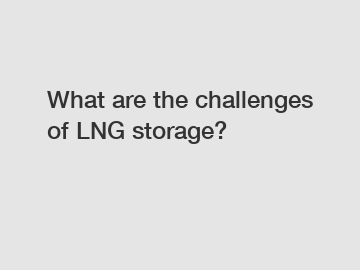What are the challenges of LNG storage?
Liquefied Natural Gas (LNG) has become a popular choice for energy storage and transportation due to its compactness compared to its gaseous state. However, storing LNG poses its own set of challenges that need to be addressed to ensure safety, efficiency, and reliability. In this article, we will explore some of the challenges of LNG storage.
**Temperature Control**.
One of the main challenges of LNG storage is maintaining the extremely low temperatures required to keep natural gas in its liquid state. LNG is stored at temperatures below -260°F (-162°C) to keep it in a liquid form. This requires specialized storage tanks that are well-insulated and equipped with systems for continuous temperature monitoring and control. Any fluctuations in temperature can lead to the conversion of LNG back into its gaseous state, causing safety hazards and loss of product.

**Pressure Management**.
Another critical aspect of LNG storage is managing the pressure within the storage tanks. As LNG evaporates, the pressure inside the tank increases. This pressure build-up needs to be carefully regulated to prevent over-pressurization, which can result in tank failure or leakage. Pressure relief valves and venting systems are essential components of LNG storage facilities to ensure the safe release of excess pressure while maintaining the integrity of the storage tanks.
**Safety Concerns**.
Safety is paramount in LNG storage due to the flammable nature of natural gas. Any leak or breach in the storage system can lead to fire or explosion, posing serious risks to personnel and the surrounding environment. Proper risk assessment, emergency response planning, and safety protocols are vital in mitigating these risks. Regular maintenance and inspection of LNG storage facilities are also crucial to identify and address potential hazards before they escalate.
**Siting and Permitting**.
The location of LNG storage facilities presents another challenge, as they need to comply with stringent siting and permitting regulations. Due to the safety and environmental concerns associated with LNG, these facilities are often subject to strict zoning laws, environmental impact assessments, and public scrutiny. Obtaining the necessary permits and approvals can be a time-consuming and complex process, requiring the involvement of various stakeholders and regulatory bodies.
**Logistics and Transportation**.
Transporting LNG from production facilities to storage sites can also be challenging, as it requires specialized vessels or trucks equipped with cryogenic tanks. The logistics of coordinating the movement of LNG across long distances while maintaining its integrity and safety add another layer of complexity to the storage process. Proper handling, loading, and unloading procedures are essential to prevent accidents and ensure the efficient transportation of LNG.
In conclusion, while LNG offers many benefits as an energy storage solution, its storage presents several challenges that need to be carefully managed to ensure the safety, reliability, and effectiveness of the storage facilities. By addressing issues related to temperature control, pressure management, safety concerns, siting and permitting, and logistics and transportation, operators can overcome these challenges and maximize the potential of LNG storage for meeting energy demands.
For more information on LNG storage solutions and services, please contact us.
If you want to learn more, please visit our website LNG Transportation Equipment, LPG Bobtail Truck with pump, CNG Storage Cascade.
154
0
0


Comments
All Comments (0)